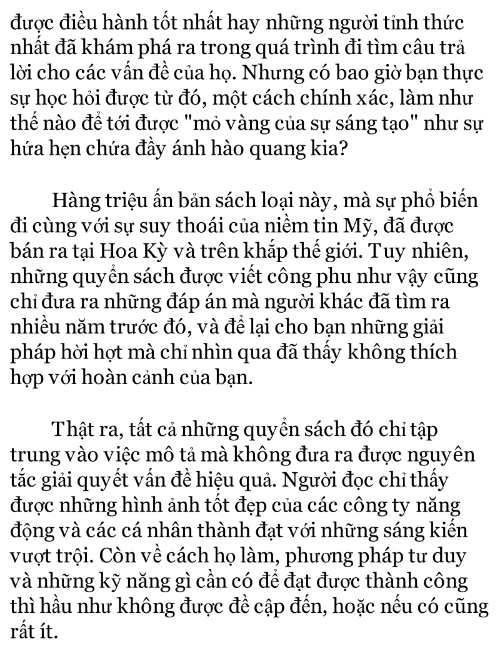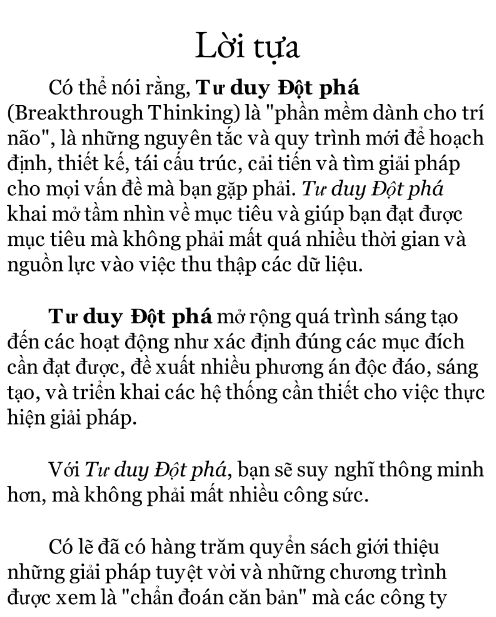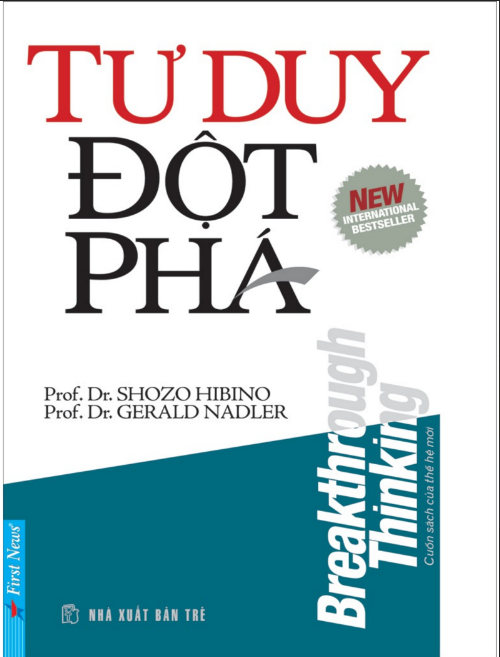


**Lời tựa** Có thể nói rằng, Tư duy Đột phá (Breakthrough Thinking) là “phần mềm dành cho trí não”, là những nguyên tắc và quy trình mới để hoạch định, thiết kế, tái cấu trúc, cải tiến và tìm giải pháp cho mọi vấn đề mà bạn gặp phải. Tư duy Đột phá khai mở tầm nhìn về mục tiêu và giúp bạn đạt được mục tiêu mà không phải mất quá nhiều thời gian và nguồn lực vào việc thu thập các dữ liệu. Tư duy Đột phá mở rộng quá trình sáng tạo đến các hoạt động như xác định đúng các mục đích cần đạt được, đề xuất nhiều phương án độc đáo, sáng tạo, và triển khai các hệ thống cần thiết cho việc thực hiện giải pháp. Với tư duy Đột phá, bạn sẽ suy nghĩ thông minh hơn, mà không phải mất nhiều công sức. Có lẽ đã có hàng trăm quyển sách giới thiệu những giải pháp tuyệt vời và những chương trình được xem là “chẩn đoán căn bản” mà các công ty được điều hành tốt nhất hay những người tinh thức nhất đã khám phá ra trong quá trình đi tìm câu trả lời cho các vấn đề của họ. Nhưng có bao giờ bạn thực sự học hỏi được từ đó, một cách chính xác, làm như thế nào để tới được “mô vàng của sự sáng tạo” như sư hứa hẹn chứa đầy ảnh hào quang kia? Hàng triệu ấn bản sách loại này, mà sự phổ biến đi cùng với sự suy thoái của niềm tin Mỹ, đã được bán ra tại Hoa Kỳ và trên khắp thế giới. Tuy nhiên, những quyển sách được viết như vậy cũng chỉ đưa ra những đáp án mà người khác đã tìm ra nhiều năm trước đó, và để lại cho bạn những giải pháp hời hợt mà chỉ nhìn qua đã thấy không thích hợp với hoàn cảnh của bạn. Thật ra, tất cả những quyển sách đó chỉ tập trung vào việc mô tả mà không đưa ra được nguyên tắc giải quyết vấn đề. Người đọc chỉ thấy được những hình ảnh tốt đẹp của các công ty năng động và các cá nhân thành đạt với những sáng kiến vượt trội. Còn về cách làm, phương pháp tư duy và những kỹ năng gì cần có để đạt thành công thì hầu như không được đề cập đến, hoặc nếu có cũng rất ít. Hãn hữu, nếu có trình bày chút ít về cách tiến hành giải quyết vấn đề thì tất cả những quyển sách trên đều lao vào sử dụng tư duy phân tích được đưa ra cách đây 400 năm bởi René Descartes và Francis Bacon, cha đẻ của khoa học và phương pháp luận. Họ thường bắt đầu câu hỏi: “Có điều gì sai lầm ở đây?” thay vào đó, không có ai hỏi: “Chúng ta đang cố gắng để đạt được điều gì?”, và cũng không có ai nhắc xem các thông tin dữ kiện nào đang ảnh hưởng tới giải pháp họ. Khác với những cách suy nghĩ trước đây, Tư duy Đột phá sẽ cho bạn một phương pháp suy luận toàn diện, được đúc kết qua 30 năm nghiên cứu về các phương pháp sử dụng trực giác của những chuyên gia gia thành công nhất trong việc giải quyết và ngăn chặn vấn đề. Có thể thấy rằng, gánh nặng về sự nhận thức dưới góc độ con người cũng chính là điểm mạnh nhất của chúng ta. Chúng ta có thể phải chịu đựng sự thống khổ trong sợ hãi – khi nhận thức được sự thay đổi dù cùng sẽ đưa đến cái chết của chính mình. Mặc dù vậy, ít nhất con người cũng được ơn phước tương đương khi có “ý thức” cao hơn mong giống loài khác. Hiển nhiên, “ý thức” đó đã cho chúng ta khả năng suy nghĩ để thích nghi một cách chủ động thông qua những ứng dụng trực tiếp năng lực của bản thân để giải quyết vấn đề. 7 Nguyên tắc Tư duy Đột phá sẽ được lần lượt trình bày cặn kẽ trong quyển sách này. Bạn hãy sẵn sàng để phát triển và áp dụng chúng cho những thay đổi khi thi nhất ngay từ hôm nay. Bạn không cần ứng dụng cả 7 nguyên tắc cùng một lúc mới có thể trở thành người có tư duy đột phá. Tuy nhiên, bạn phải thấm nhuần toàn bộ 7 nguyên tắc tắc và luôn áp dụng ít nhất hai nguyên tắc cơ bản của Tư duy Đột phá vào việc giải quyết mọi vấn đề: đó là nguyên tắc về Sự Khác nhau Độc đáo và nguyên tắc Triển khai Mục đích. Nếu bạn không chấp nhận sự thật rằng mỗi vấn đề đều khác nhau và tiếp cận vấn đề theo tinh thần đó bằng cách luôn đặt câu hỏi về mục đích cần đạt được của giải pháp, bạn sẽ bị bóp buộc, thậm chí hoàn toàn đánh mất khả năng đột phá. Nhiều nhà lãnh đạo tại Mỹ đang lao vào tiếp nhận và ứng dụng các triết lý kinh doanh của người **Hình 2:** Copyright © 2021 by John Wiley & Sons, Inc. All rights reserved. Published by John Wiley & Sons, Inc., Hoboken, New Jersey. Published simultaneously in Canada. No part of this publication may be reproduced, stored in a retrieval system, or transmitted in any form or by any means, electronic, mechanical, photocopying, recording, scanning, or otherwise, except as permitted under Section 107 or 108 of the 1976 United States Copyright Act, without either the prior written permission of the Publisher, or authorization through payment of the appropriate per-copy fee to the Copyright Clearance Center, Inc., 222 Rosewood Drive, Danvers, MA 01923, (978) 750-8400, fax (978) 646-8600, or on the Web at www.copyright.com. Requests to the Publisher for permission should be addressed to the Permissions Department, John Wiley & Sons, Inc., 111 River Street, Hoboken, NJ 07030, (201) 748-6011, fax (201) 748-6008, or online at http://www.wiley.com/go/permissions. Limit of Liability/Disclaimer of Warranty: While the publisher and author have used their best efforts in preparing this book, they make no representations or warranties with respect to the accuracy or completeness of the contents of this book and specifically disclaim any implied warranties of merchantability or fitness for a particular purpose. No warranty may be created or extended by sales representatives or written sales materials. The advice and strategies contained herein may not be suitable for your situation. You should consult with a professional where appropriate. Neither the publisher nor author shall be liable for any loss of profit or any other commercial damages, including but not limited to special, incidental, consequential, or other damages. For general information on our other products and services or for technical support, please contact our Customer Care Department within the United States at (800) 722-7927, outside the United States at (317) 572-3993 or fax (317) 572-4002. Wiley publishes in a variety of print and electronic formats and by print-ondemand. Some material included with standard print versions of this book may not be included in e-books or in print-on-demand. If this book refers to media such as a CD or DVD that is not included in the version you purchased, you may download this material at http://booksport.wiley.com. For more information about Wiley products, visit www.wiley.com. Library of Congress Cataloging-in-Publication Data Names: Kotler, Philip, author. | Kartajaya, Hermawan, 1947- author. | Setiawan, Iwan, author. Title: Marketing 5.0 : technology for humanity / Philip Kotler, Hermawan Kartajaya, Iwan Setiawan. Description: Hoboken, New Jersey : Wiley, [2021] | Includes index. Identifiers: LCCN 2020046415 (print) | LCCN 2020046416 (ebook) | ISBN 9781119668510 (hardback) | ISBN 9781119668572 (adobe pdf) | ISBN 9781119668541 (epub) **Hình 3:** What’s new in the 7th edition? I was playing golf with a friend, who asked me what was the latest book I was working on (excuse his terrible grammar). When I told him it was the seventh edition, no less, of our best-selling marketing communications book, he replied, “Well I hope you get it right this time!” I think we have. Ze and I are delighted to have gathered an array of intriguing, cutting edge examples of marketing communications in action, underpinned by academic theory, all written in a very practical way. In fact, we hope you enjoy it as we really want to ‘educate’ you and perhaps even ‘wow’ you occasionally. As we know, having to read through volumes of books can be fatiguing, so we try to lighten your load with the occasional intriguing, controversial or even mildly humorous examples. Something that has become screamingly obvious is that tactical communications tools never work in isolation. For many years now, we have been pushing marketing communications integration, ie integrate everything in order to leverage and maximize the impact of each tactical marketing communications tool. In fact, we’ve been saying this for a quarter of a century (the first edition in 1993 was Marketing Communications: An integrated approach). Today, it is impossible to isolate any tactic, as marketers today think in an integrated way – whether it is a micro-site built for an ad campaign with a contact strategy of an email followed by a tailored landing page/microsite followed by some remarketing, marketers today think integrated, which is great. You’ll see this in all the mini cases at the end of each chapter in Part Two. Even this is changing, as AI-driven chatbots can shorten this sequence and deliver far better leads, as we show in Chapter 11. From time to time, you will think, ‘Hang on, shouldn’t this case study actually be in another chapter?’, because it will feature other tactical tools almost as much as it does the tool being discussed in that chapter. Personalized videos at scale appear in several places. Pedigree’s AI-driven app is in the packaging chapter (Chapter 19), but it could have featured in content marketing and sales promotion. You will see a lot of this. In addition to demonstrating the maturing of marketing automation, content marketing, single user experience and the lifetime journey, we are delighted to tell you that we have included materials from the best in the world including America’s Larry Kim (Facebook bots and unicorns) and Mark Schaefer (content shock and the human-centred approach to marketing). Banksy (the street artist and his world’s greatest PR stunt), Greenpeace, Al companies and generally corporations that use both the left brain (analytics and data) and the right brain (creative thinking) approach to marketing. We have a broader international range of examples, with world-class campaigns from the UK, Europe, the USA, Ireland, India, Sri Lanka and Brazil. We have put a lot more emphasis on data and AI in particular. In fact, references to AI and data appear throughout the book. AI is here to stay. As is the clever use of data. We also explore the misuse of data. We also include the hidden Web and how it was used by the Leave campaign, which was subsequently found to have broken the electoral laws and advertising principles: ‘legal, decent, honest and truthful’. We include links to the hidden Web ads that Facebook initially refused to release. You can see the need for data protection, and hence the importance of GDPR is emphasized. Hence there is a need for, and we encourage, a more responsible approach to marketing, as demonstrated by Mark Schaefer’s human-centred marketing. His infographics on p 315 should generate a heated discussion or two. Finally, the last photo in the book (p 636) includes ethics, which, ironically, might be objectionable to some, but it is as it is a brilliant example of ‘mining owned media’ by a small semi-pro football club in the South of England. The applications of the VISTAC® Planning framework have been updated in Part One and applied throughout the second half of the book. Overall, we hope you find this edition more challenging and enlightening than ever before. Read on. **Hình 4:** This book should not be read from cover to cover but rather it should be used as a reference when addressing a particular aspect of marketing communications. The integrated nature of the subject does, however, refer the reader to other chapters and sections that are relevant to the particular area of interest. The anecdotal style, examples, case studies, questions, key points and sections have been carefully structured so that the reader can dip into an area of interest, absorb the information and cross-refer if required. This allows the reader to extract specific answers quickly and easily. This book is designed to entertain as well as inform and so it is hoped that when dipping into a particular area, the reader will be lured into reading more. Part 1 (see Figure 0.1) Chapter 1 introduces the new thinking and new tools (largely driven by marketing automation, social media, virtual worlds and new analytics tools) alongside 100-year-old business principles that are, surprisingly, much required today. Part 1 continues to build a background to marketing communications by exploring branding, customer relationship management, buyer behaviour, consumer and communications theory and how information reduces risk (what information market research can and cannot provide), how to work with agencies and consultancies of all types, moving in the changing business environment, international marketing and ultimately shows how to write a marketing communications plan using the simple S O S T A C® planning framework. Part 2 covers specific marketing communication tools that marketing professionals have to manage at some time or other. These include selling and sales management (and Key Account Management), advertising, PR, sponsorship, sales promotion (particularly free ‘content marketing’), direct mail, exhibitions (all online and offline), packaging, and finally, websites that work and social media that wins. The case studies at the end of each chapter in Part 2 have been carefully selected to show a range of different types and sizes of organizations using various communications tools across a range of different industries and markets. Materials are drawn from both small organizations with small budgets and larger businesses with multi-billion-dollar budgets. This book should prove useful to anyone interested, or working, in marketing. The reader will discover that all of the communication tools can and should integrate with each other, as shown in Figure 0.2 and explained at the end of Chapter 1. Equally we need to be able to think creatively (right brain) and analytically (left brain) to make better-quality marketing decisions to ensure we satisfy exactly what our stakeholders need, at the right time in the right place amidst the white heat of competition. It is sometimes difficult to separate and categorize an activity as being one type of tool or another. For example, direct marketing and sales promotions should probably be called ‘direct responses’ since they both more than likely involve each other. The chapters are not listed in order of importance. Selling and sales management is not always included in a marketing communications budget but the sales force is a potent form of communication and generally they (or the sales manager) report to the marketing manager. In fact it has been put to the top of the list because all the other chapters thereafter tend to lead into each other. The successful application of the marketing communications mix is helped by an understanding of communication theory and buyer behaviour theory. Marketing research can provide some practical and specific answers to the questions that theories generate. This provides the building blocks for the marketing communications plan, which draws upon an understanding of how agencies operate and how different media work. The details of the plan are worked out within the sometimes complex, but always integrated, web of the marketing communications mix (see Figure 0.2). The changing marketing communications environment and international opportunities/threats constantly affect the whole marketing communications mix. The world has moved on since the sixth edition. Different organizations allocate the same communication tools to different departments/budgets,


